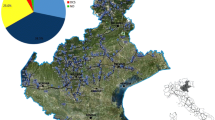Abstract
A structural health monitoring system was installed on the 60-year-old Diefenbaker Bridge, located in Prince Albert, Saskatchewan, Canada, to investigate in-situ bridge behaviours, such as the degree of composite action, lateral load distribution, and dynamic load influence. The 304 m long, seven span bridge consists of two separate fracture critical superstructures, each comprising a cast-in-place concrete deck supported by two non-composite welded wide flange girders. Previous studies, based solely on a structural analysis, concluded that the connection of the lateral bracing to the girder web had less than 5 years of remaining fatigue life. Due to the uncertainty involved in this calculation, the data acquired from 6 months of field monitoring were used to define the structure’s response to live loading, and to calibrate a finite element model that was used to characterize the three-dimensional stress state at that connection. It was found that unexpected composite action, increased load sharing between the girders, and minimal dynamic load influence exist in the bridge. Results were compared with those obtained using the Canadian Highway Bridge Design Code (CAN/CSA S6–14). Based on the monitoring results, it was concluded that costly improvements to the connection detail were not required, since the remaining fatigue life was estimated to be at least 52 years. In addition, it was found that the exterior girders are more heavily loaded than the interior girders, and the northbound structure is more heavily loaded than the southbound, permitting the location of the most critical connection for fatigue life to be identified.


















Similar content being viewed by others
References
Stantec consulting (2015) Diefenbaker Bridge management plan, City of Prince Albert, Prince Albert, Saskatchewan, Canada
ISL Engineering and land services (2016) Diefenbaker assessment and evaluation report, Saskatchewan ministry of highways and infrastructure, Saskatoon, Saskatchewan, Canada
Zhou Y (2006) Assessment of bridge remaining fatigue life through field strain measurement. J Bridge Eng 11(6):737–744
Fasl J. (2013) Estimating the remaining fatigue life of steel bridges using field measurements, Ph.D. dissertation, the university of Texas at Austin
AASHTO (2018) The manual for bridge evaluation, 2nd edn. American association of state highway and transportation officials, Washington, DC, USA
Connor R, Fisher J (2006) Identifying effective and ineffective retrofits for distortion fatigue cracking in steel bridges using field instrumentation. J Bridge Eng 11(6):745–752
Fisher J, Mertz D, Zhong A (1983) Steel bridge members under variable amplitude long life fatigue loading. Transportation research board national research council, Washington, D.C., USA
AASHTO (2017) LRFD bridge design specification, 8th edn. American association of state highway and transportation officials, Washington, DC
Swenson K, Frank K (1984) The application of cumulative damage fatigue theory to highway bridge fatigue design. Center for transportation research, Austin, TX
Leander J, Andersson A, Karoumi R (2010) Monitoring and enhanced fatigue evaluation of a steel railway bridge. Eng Struct 32:854–863
Stantec Consulting (2013) Prince albert area second bridge river crossing study, City of Prince Albert, Saskatchewan, Canada
CAN/CSA S6-14 (2014) Canadian highway bridge design code, Canadian standards association, Rexdale, Ontario, Canada
National cooperative highway research program (1990) Distortion induced fatigue cracking in steel bridges, NCHRP Report 335. Transportation research board, national research council, Washington, DC, USA
Beer F, Johnston E, Dewolf J, Mazurek D (2009) Mechanics of materials, 5th edn. McGraw-Hill, New York, NY, USA
ASTM E1049-85 (2011) Standard practices for cycle counting in fatigue analysis, ASTM International, West Conshohocken, PA, USA
CSI (2019) SAP 2000 integrated software for structural analysis and design. Computers and structures Inc., Berkeley, California, USA
ANSYS Inc. (2019) ANSYS simulation software, version 19, Delaware, USA
Ontario ministry of transportation (2008) Ontario structure inspection manual. Toronto, ON, Canada
Feldman L, Jackson K, Sparling B, Sparks G (2011) Comparison of load rating techniques for the red deer river bridge. Can J Civ Eng 38(10):1072–1081
Miner M (1945) Cumulative damage in fatigue. J Appl Mech 12:A159–A164
Moses F, Schilling C, Raju K (1987) Fatigue evaluation procedures for steel bridges. Transportation research board, national research council, Washington, D.C. USA
Author information
Authors and Affiliations
Corresponding author
Ethics declarations
Conflict of interest
The authors have no relevant financial or non-financial interests to disclose. This manuscript has no associated data.
Additional information
Publisher's Note
Springer Nature remains neutral with regard to jurisdictional claims in published maps and institutional affiliations.
Rights and permissions
About this article
Cite this article
Morgan, C.J., Sparling, B.F. & Wegner, L.D. Use of structural health monitoring to extend the service life of the Diefenbaker Bridge. J Civil Struct Health Monit 12, 913–929 (2022). https://doi.org/10.1007/s13349-022-00585-1
Received:
Revised:
Accepted:
Published:
Issue Date:
DOI: https://doi.org/10.1007/s13349-022-00585-1




